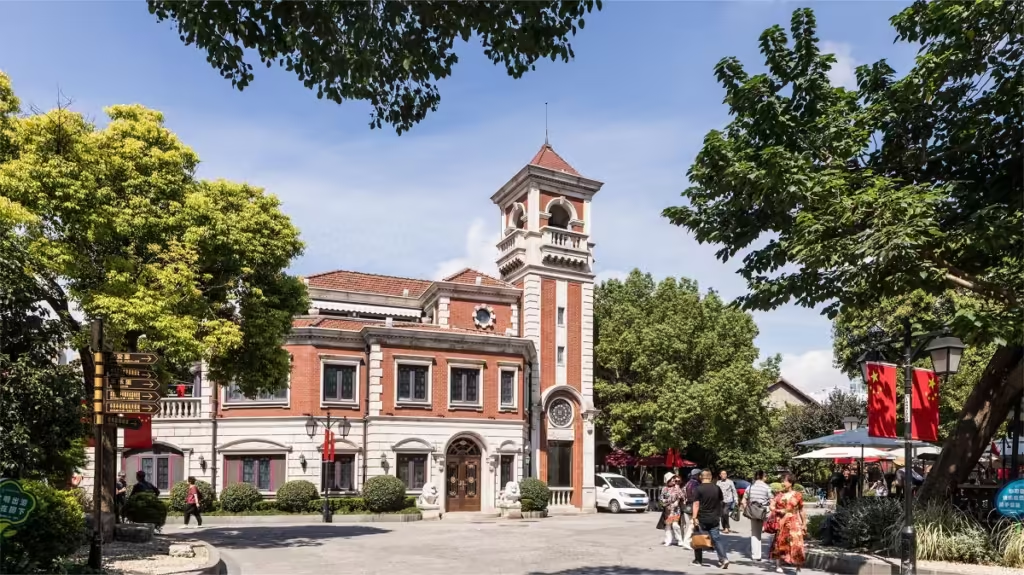“One Duolun Road, a century of Shanghai.” Duolun Road, originally named Doulean Road, is a small street in Shanghai. Shaped like an L, this street connects to Sichuan North Road at both ends and spans just over 500 meters. Despite its modest appearance, Duolun Road has played a significant role in modern Chinese cultural history. In the 1920s and 1930s, it served as the stronghold of the Left-Wing Writers’ Union, with the headquarters and memorial hall still preserved here today. Many notable figures, including left-wing writers and social celebrities of the time, such as Lu Xun, Mao Dun, Guo Moruo, Ye Shengtao, and Zhang Aiping, had their residences on this street. Their literary activities established Duolun Road’s cultural significance.
In addition to the former residences of these famous figures, Duolun Road is also home to several small private museums. These include the Chopsticks Museum (No. 191 Duolun Road), Asia’s largest ancient coin exhibition hall (No. 35, Lane 203, Sichuan North Road, formerly Tang Mansion), the Nanjing Clock Museum (No. 193 Duolun Road), and the Wenfeng Strange Stone Collection Museum (No. 189 Duolun Road). Other private collections on the street include the Ex Libris Museum, Newspaper Collection Museum, and Ancient Ceramics Collection Museum, with their signboards often inscribed by cultural celebrities.
Travel Information about Duolun Road
Tickets and Opening Hours
Tickets: Free
Opening Hours: Open all day
Getting to the Scenic Area
Location: Hongkou District, Shanghai
Transportation: Take Metro Line 3 to Dongbaoxing Road Station, then walk to the site.
Scenic Rating
Beauty: ★★★★★
Leisure: ★★★★★
Cultural Significance: ★★★★★
Romance: ★★★★
Distinctive Features: ★★★★
Excitement: ★★★
Highlights of Duolun Road
Former Site of Chinese Left-Wing Writers’ Union
As you enter Duolun Road, the first building that catches your eye is the Kong Mansion at No. 250, built in 1924. This structure is notable for its Islamic-style arches and pillars, adorned with Arabesque patterns and colorful facades, forming a distinctive and harmonious composition.
At No. 2, Lane 201, Duolun Road, you’ll find the former site of the Chinese Left-Wing Writers’ Union, hidden within a narrow alley. This three-story Western-style house was once home to the China Academy of Art, founded by Chen Wangdao and others. On March 2, 1930, the Chinese Left-Wing Writers’ Union held its founding meeting here. The “Left-Wing Writers’ Union” exhibition hall on the upper floor highlights how the Union’s establishment marked a new phase in modern Chinese literature following the May Fourth New Culture Movement. The Union nurtured a generation of young writers who became involved in revolutionary activities. Works such as A Ying’s Night Flight Collection, Mao Dun’s Midnight, and Harvest with a preface by Lu Xun were all products of this era. Between 1930 and 1936, over 480 members and hundreds of works emerged, underscoring the significant role the Union played in both Chinese literary history and the Chinese revolutionary movement.
Various Museums
The Qishi Museum, owned by Mr. and Mrs. Chen Zhou, has been devoted to stone collecting since 1949. Their collection includes over 10,000 unique stones from more than 100 different types, with Yuhua (Water) Stones, Lingbi (Meteorite) Stones, Jianghe (River Pebbles), and various figurative stones being particularly noteworthy.
The Chopsticks Museum is the only folk chopsticks museum of its kind in China, housing more than 980 different types of chopsticks from ancient to modern times, both domestic and international, with a total of over 1,600 pairs. It’s a fascinating place to visit.
The Clock Museum, located at No. 193 Duolun Road and owned by Liu Guoding, specializes in the collection of ancient clocks from Nanjing. The museum has amassed more than 70 different types of Nanjing clocks, offering a unique glimpse into the past.
The Jinquan Ancient Coin Museum boasts a collection of over 10,000 coins. Notable treasures include the bronze coin “Baode Copper Shell,” a small denomination copper note from the Jin Dynasty, and the “Xianfeng Tongbao · Daqing Yibai” copper coin, which set a record for the highest auction price of ancient Chinese coins, purchased for 275,000 yuan. Those interested in ancient currency will find it a must-see.
Old Movie Café
Within the street, there’s a place called the “Old Movie Café.” The entrance is adorned with faded vintage movie posters from old Shanghai, and inside, the café houses a collection of over 100 classic films, including some of the earliest silent movies. A rear-projection TV in the café plays a continuous loop of classic films, ranging from the silent era to iconic films from the 1930s and 1940s, both domestic and international. The day’s movie schedule is conveniently displayed on a small chalkboard at the entrance.
Food Options in Duolun Road
Duolun Road is home to several charming cafés and fine dining restaurants where you can savor delicious food while soaking in the rich cultural atmosphere.
Old Movie Café: Located at 123 Duolun Road, this café is full of nostalgic charm, constantly playing old movies that evoke the feeling of old Shanghai.
Gongfei Café: This café is the birthplace of the Chinese League of Left-Wing Writers, mentioned by Lu Xun in his work Revolutionary Café. It still retains its original cultural ambiance.
Darroch Restaurant: Situated on the famous Duolun Road, this Western restaurant offers an elegant environment. The Tomahawk steak and sirloin steak here are highly recommended.

